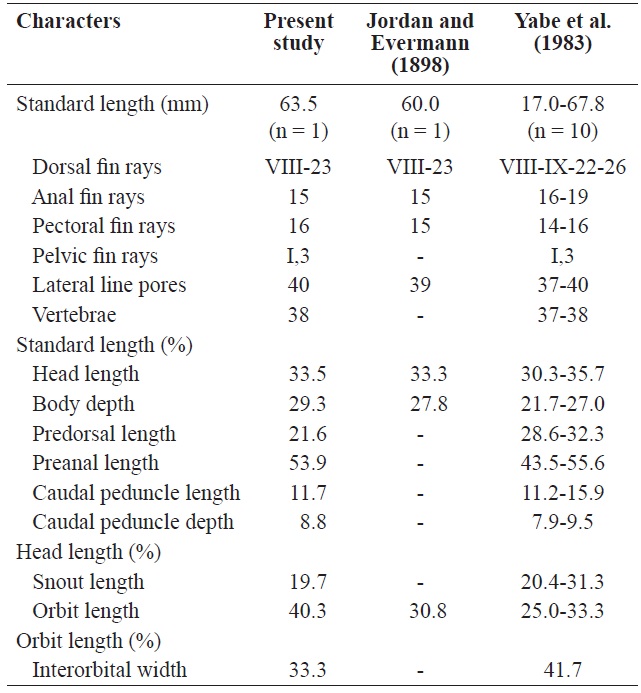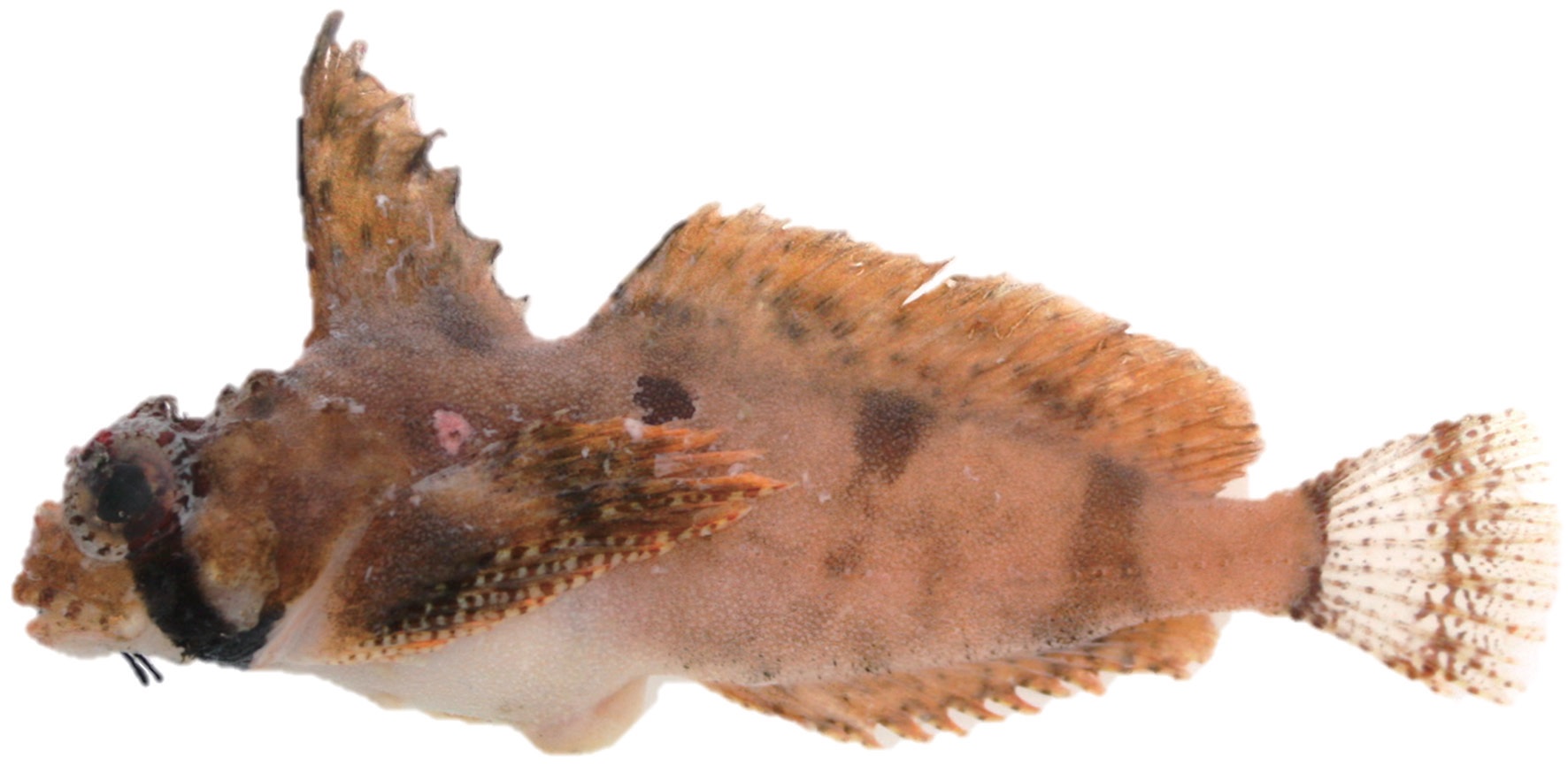



A new record of the eyeshade sculpin Nautichthys pribilovius is described on the basis of a single specimen collected from the East Sea, Korea. The species has 23 second dorsal fin rays, rounded spines on the occiput, a black band through the eye and across the cheek, branched caudal fin rays and a branchiostegal membrane attached to the isthmus. The new Korean name “Gum-eun-tti-nunhoet- dae-sok” is proposed for the genus Nautichthys, and “Gum-eun-tti-nun-hoet-dae” is proposed for the species N. pribilovius.
The Hemitripteridae, of the order Scorpaeniformes, consists of eight species and three genera worldwide (
During a survey of the fish fauna in the East Sea, a single specimen belonging to the genus
In March 2013, a single specimen of
(NIBR), Korea.
(new Korean genus name: Geom-eun-tti-nun-hoet-dae-sok )
Upper surface of head spinous. Mouth moderate; the jaws subequal; teeth on jaws, vomer and palatines. Dorsal fins contiguous at their base; first one shorter than the second. Three soft rays on pelvic fin. Caudal fin rays branched; caudal fin
[Table 1.] Comparison of counts and measurements of Nautichthys pribilovius

Comparison of counts and measurements of Nautichthys pribilovius
rounded. Body covered with minute spines. Diagonal black band present through the eye and across cheek. Branchiostegal membranes attached to the isthmus (Girard, 1858; Eschmeyer and Herald, 1983; Yabe, 1985).
(new Korean name: Geom-eun-tti-nun-hoet-dae) (Table 1, Fig. 1)
NIBR-0000020388, one specimen, 63.5 mm in standard length (SL), Sokcho-si, Gangwon-do, Korea, 11 Mar, 2013, collected by Yeon-Soo Jung, 35-50 m depth, set net.
Counts and measurements are given in Table 1. Dorsal fin rays, III-23; anal fin rays, 15; pectoral fin rays, 16; pelvic fin rays, I, 3. Body proportions, expressed as percentages of SL: head length, 33.5; body depth, 29.3; predorsal length, 21.6; preanal length, 53.9; caudal peduncle length, 11.7; caudal peduncle depth, 8.8.
Body deep and compressed; eye large; interorbital space narrow and deeply concave; interorbital length ~30% of eye diameter; upper margin of orbit protruding well above dorsal profile of head as a blunt triangular ridge; dorsal origin elevated; branchiostegal membranes attached to the isthmus; the gill slit extending a little below the lower edge of the pectoral fin; nasal spine present; large multiple filament on upper part of each eye; slender filament present on nasal base, lower margin of suborbital and posterior end of maxillary; posterior end of maxillary reaching to the middle of the eye; teeth on jaws, vomer and palatines; four preopercular spines, short and blunt; the lateral line noticeable, lateral line plates with short spines directed backward; dorsal fins separate, the first dorsal spine highest; the posterior end of pectoral fin reaching to the ninth soft ray of the second dorsal fin and passing the origin of anal fin; minute spines covering the body, except for the pectoral axilla, anterior region of anal origin, jaws, and ventral face of head; caudal fin rays branched.
When fresh, head and body yellowish brown, ventral body white, three dark bands present below the soft dorsal fin rays; black band present through the eye and across cheek, extending onto branchiostegal membranes and isthmus; first dorsal fin dusky, first dorsal spine very dark; second dorsal, anal, and pectoral fins dotted; caudal fin faint yellowish brown, with a line across base of caudal fin and a broader line across caudal fin towards its tip. After alcohol fixation, head and body pale brown. Three dark bands present below dorsal soft rays; two ambiguous dark bands present below dorsal spines; noticeable dark band present through the eye and across cheek; first dorsal fin dark, and other fins dotted, except for pelvic fin; caudal fin with faint dark lines across at its base and posterior.
Known from the Bering Sea, northern Okhotsk Sea, west coast of Sakhalin, the northern East Sea, Artic Ocean (Neylov, 1976; Mecklenburg et al., 2011) and the East Sea, Korea (the present study).
Based on the meristic characters (Table 1), our single specimen clearly matches

